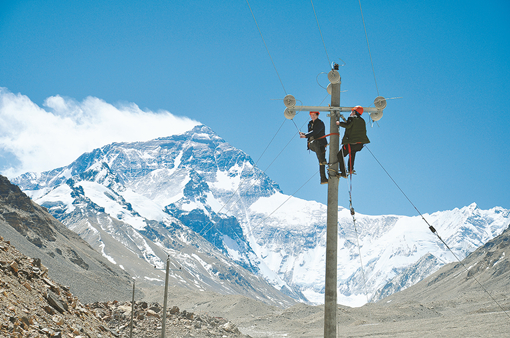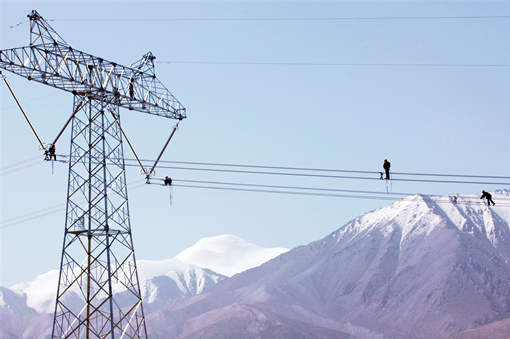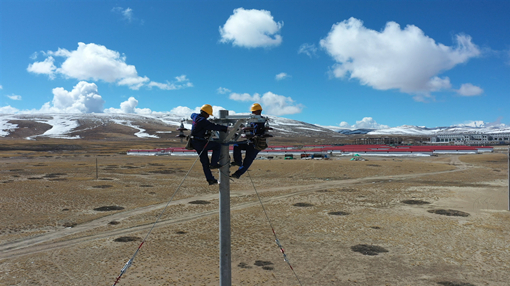from:China Electricity Councildate:2020-06-28
On May 27, a team of Chinese surveyors measuring the height of Mount Everest scaled the mountain, gaining national acclaim. After summiting, team members erected a survey marker on the snow-covered peak and installed GNSS antennas for the re-measurement. Behind the success stands State Grid powering the Everest Base Camp.
Power grid was built on the height of 5,200m six years ago
At 16:00 on April 12, 2014, the Everest Base Camp at the altitude of 5,200 meters was powered up with the switch-on of a 10kV transmission line. State has lit up the world’s highest peak through large power grid.

Construction site of a 10 kV transmission line powering Everest Base Camp.
Everyone can imagine how difficult it is to build power grids at the height of 5,200m on the roof of the world with thin air where walking is strenuous for ordinary people. In addition, the Qinghai-Tibet Plateau features washboard roads which are formed due to its changing climate, temperature and geological structure. People in vehicles running on such roads would have a feeling on a massage chair with high frequency and small amplitude and become dizzy within a 100-metre travel. So extremely strong willpower is required to drive and work for long periods under such conditions.
“Nearly 200 construction workers have been working at the altitude of over 5,000m under extremely harsh conditions with strong winds, thin oxygen, washboard roads and steep hills for nine months, erecting transmission lines of 85km and building grids for areas without access to electricity in Tingri County. These efforts have brought an end to the intermittent power supply from solar power and generators,” said Penpa Dhondup, the project leader and then Deputy Director of the Development and Construction Department of Shigatse Power Supply Company.
The 10 kV power supply project on Mount Everest is a project to bring "electricity to every household" in Tibet and a major step taken by State Grid to implement the decisions of the central government and serve the long-term stability in Tibet. As an important component of power grid projects in areas without electricity in Tingri County, Shigatse, the project has brought safe and stable electricity to 1,011 households in 21 villages and Rongbuk Monastery, the highest temple in the world. It not only greatly improves life quality of local residents, but also ensures stable and sufficient power supply for scientific research (including measuring and mountaineering) and tourism activities.
Powering Everest Base Camp is as significant as summiting its peak
Powering Everest Base Camp via grids has ended the intermittent power supply from solar power and diesel generators, providing more convenient electricity to mountaineers and researchers.

Qinghai-Tibet Interconnection Project
Kunbo, 82, was ecstatic after he knew grid connection of Everest Base Camp. On May 25, 1960, he and two fellows became the first to ascend the summit of Mount Everest from the North Slope. This was the first time that the flag of China had flown on the world’s highest peak.
“It was dark when we climbed peak, so we could only move forward cautiously,” Gonpo said. “It would have been better if there was light then. It was 20 years ago that I went to Everest Base Camp last time. At that time, we only relied on generators, and were sparing with the electricity. If it was necessary to transmit a message, power was temporarily produced. Grid connection of Everest Base Camp is as great as human beings climbing the peak itself.”
There is a row of yellow tents for mountaineers to stay at Everest Base Camp. All tents are the same without numbers. If mountaineers cannot find their own tents at night with gales and low temperatures (several dozen degrees below zero Celsius), serious consequences would be led. Now this problem is solved with bright lights. “Since 2000, I have been cooking at Everest Base Camp each year when mountaineering activities are held. These few years have witnessed great changes. In the past, we used more than 10 pressure cookers at the same time, while the rice was not easy to cook. However, we can now make enough rice for 60 people by using only one electric steamer. Furthermore, thanks to today's advanced tools such as electric baking pans and electric noodle machines, I am given the chance to display my full skill set as a senior chef,” said Phurbu Tsering, one of support personnel in the rear for surveyors of this re-measurement.
In 2016, Wang Zhongyan, then Deputy Director of Qomolangma Atmospheric and Environmental Observation and Research Station, CAS (QOMORS) traveled to Everest Base Camp to conduct scientific research about 10 times per year. Wang said that State Grid supplied stable and sufficient power to the station, greatly facilitating the implementation and planning of scientific observation, in particular the use of high-power instruments.
Since 2019, in order to better protect Mount Everest, all private cars have been banned from the Mount Everest Scenic Area and replaced by electric shuttle buses. This would not be possible without grid power.
Upgrading power supply for Everest Base Camp by replacing overhead lines with cables
To improve power supply reliability, State Grid replaced the overhead lines of Everest Base Camp with cables in 2016.
About one year after Everest Base Camp getting grid electricity, a new round of rural grid upgrade in Tibet has been extended to 23 remote villages at the foot of Mount Everest.

Construction site of the grid project in Lizi, Zhongba County, Shigatse
State Grid takes the initiative to serve economic and social development in Tibet and strives to provide power to areas without electricity. A series of projects have been completed, such as “electricity to every household” of rural grids at prefectural and municipal levels, a new round of rural grid upgrade from 2016 to 2017 and grid construction in deeply impoverished areas in Tibet since 2018. Qinghai-Tibet Interconnection Project, Sichuan-Tibet Interconnection Project and Central Tibet Interconnection Project have been completed and put into operation in recent years.
By 2019, the main grid of the Tibet Autonomous Region has covered 66 counties, providing power for 2.9 million people which accounts for 84% of the total population of Tibet.
Tel:+86-25-84152563
Fax:+86-25-52146294
Email:export@hbtianrui.com
Address:Head Office: No.8 Chuangye Avenue, Economic Development Zone, Tianmen City, Hubei Province, China (Zip Code: 431700) Nanjing Office: Room 201-301, Building K10,15 Wanshou Road,Nanjing Area, China (Jiangsu) Pilot Free Trade Zone,Jiangsu Province,China (Zip Code:211899)
